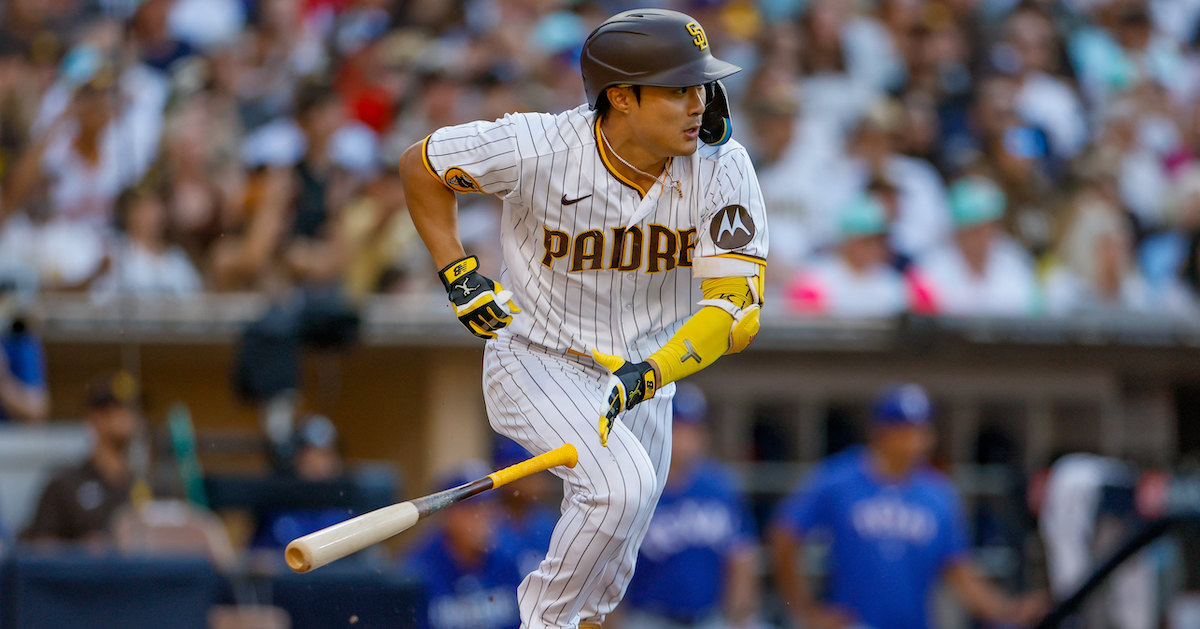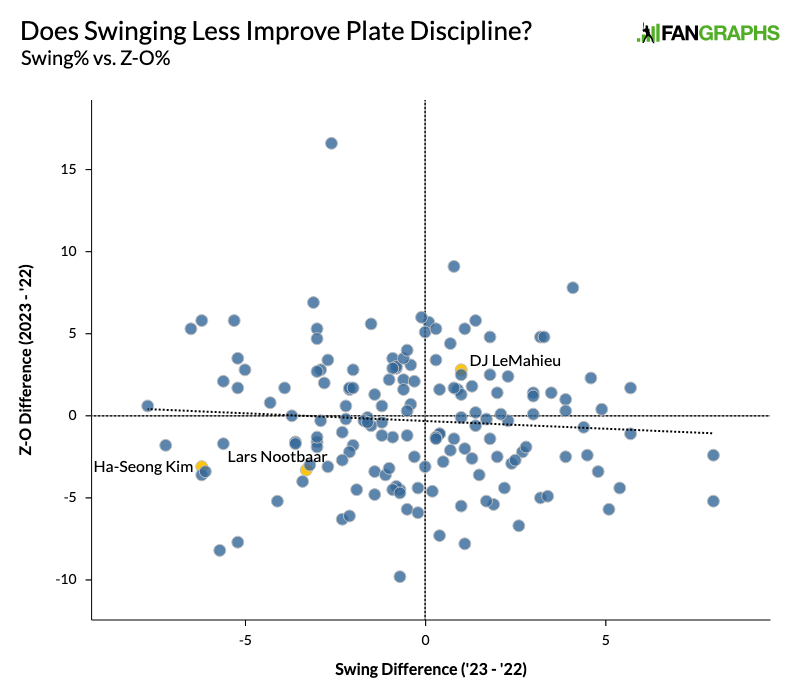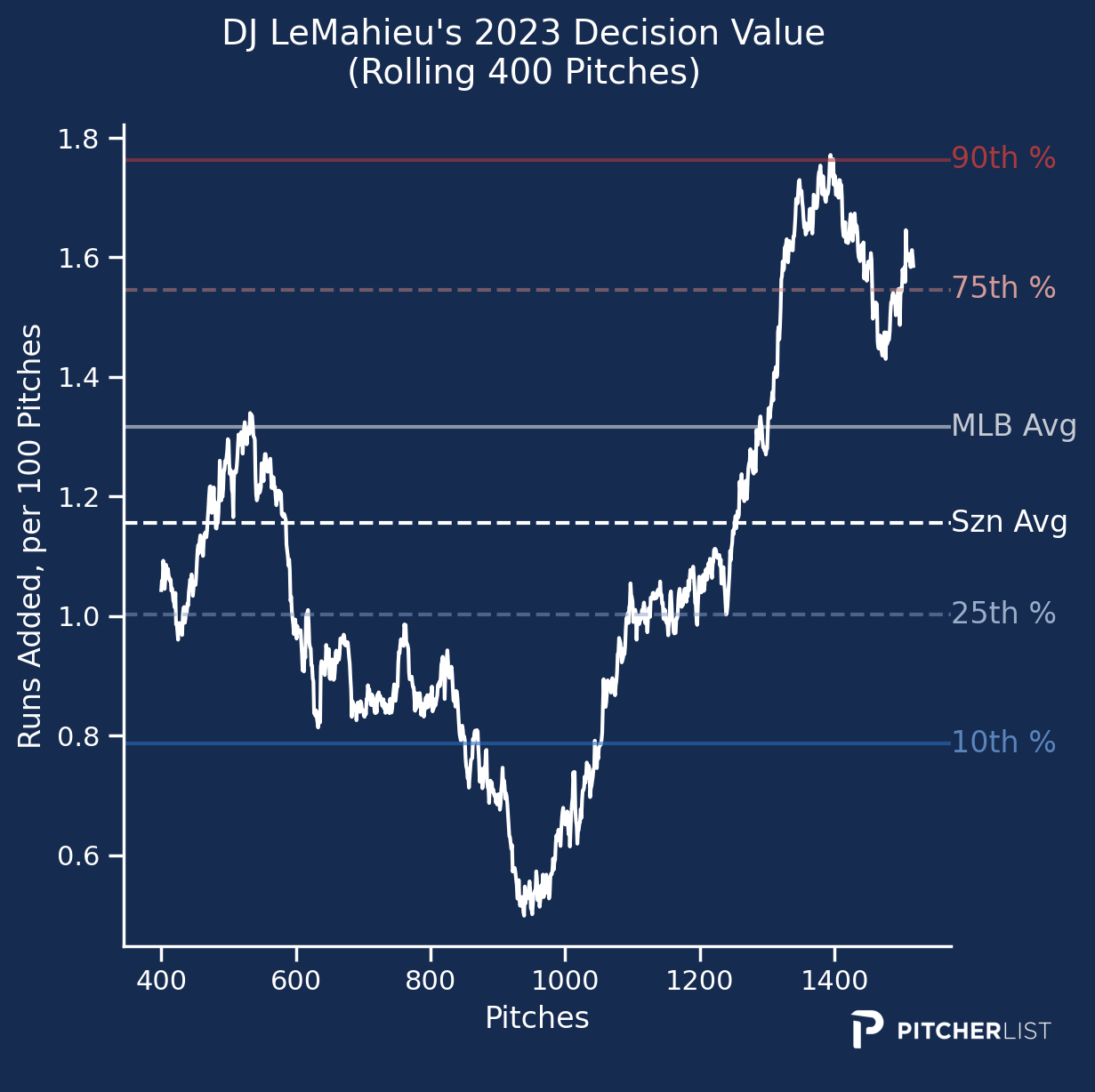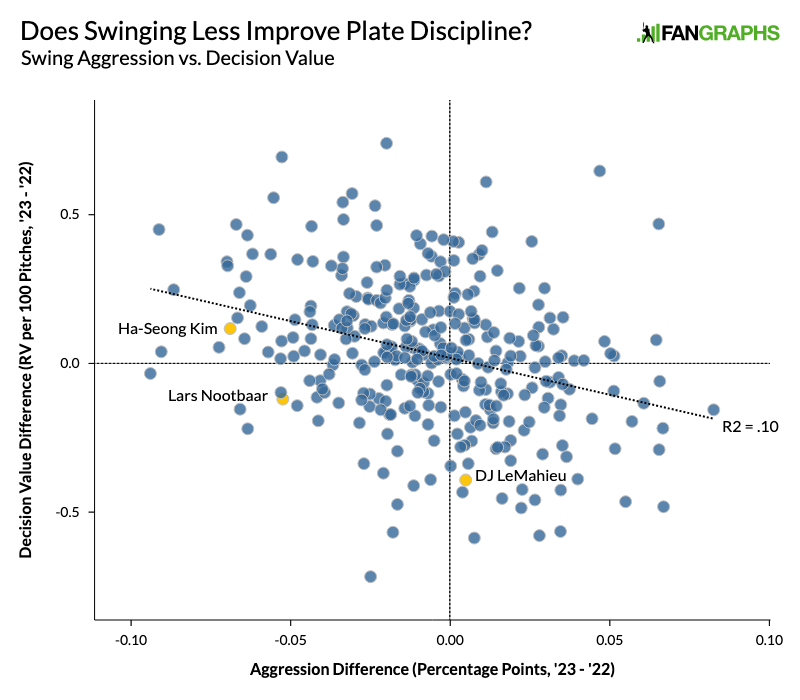
Final week over at Pinstripe Alley, I investigated DJ LeMahieu’s current scorching streak. Naturally, he received injured as quickly as I completed writing, however I went via with the piece nonetheless as a result of I felt like I used to be onto one thing. Particularly, I observed that LeMahieu’s struggles this 12 months got here when pitchers had been difficult him extra; in consequence, he was swinging extra, however proportionally, extra of these swings occurred to come back on balls than when pitchers had been being stingy with their strikes.
When making an attempt to contextualize LeMahieu’s scorching stretch, I observed one other hitter who’s been on fireplace currently due to some improved self-discipline: Ha-Seong Kim. Over the previous 30 days, he’s tied for the key league lead in WAR with Freddie Freeman at 2.1. A few of that manufacturing has come from his usually wonderful protection, however Kim has been no slouch with the bat both; in that span, he’s posted a 189 wRC+, eighth-highest amongst 167 qualifiers. Maybe most notably, he’s additionally tied (with Lars Nootbaar and Alex Bregman) for the second-best BB-Okay price, behind solely Marcus Semien.
Previous to that 30-day stretch, Kim’s swing price was already a career-low, and his BB-Okay price close to a career-best. However his swing price has dropped even additional within the final 30 days, rating second-lowest at 34.2% to Nootbaar’s 34.1%, and his BB-Okay price has gone from destructive to constructive; now it’s undoubtedly a career-best. Nootbaar has adopted an analogous trajectory: his swing price was already a career-low and has sunk even additional, and his BB-Okay price is now approaching a career-best due to his personal torrid month.
One query this raises: are hitters extra productive once they swing much less? Eno Sarris of The Athletic discovered that typically, sure, they’re. However why? Being affected person and letting the ball journey can truly lower a hitter’s residence run likelihood; making contact out in entrance of the plate offers one of the best probability at a dinger.
Some hitters with elite eyes, like Juan Soto, can seemingly resolve to swing at fewer balls with out having to attend for pitches to journey extra. This not solely permits them to take care of their typical level of contact once they do swing, however it additionally results in extra high-ball counts and thus walks. However what about “unhealthy ball” hitters? Is it price it for them to take extra walks on pitches they’ll drive? And what about hitters with poor eyes; if they’ll’t merely begin taking solely balls, aren’t they sure to face extra referred to as strikes as properly?
Let’s sort out that final query first by asking one other: does swinging much less result in higher swing selections in mixture? One of many extra tried-and-true measures of plate self-discipline for the reason that introduction of PITCHf/x has been Z-Swing% minus O-Swing%, or a hitter’s swing price on pitches contained in the zone minus their swing price on pitches outdoors of the zone. By this measure, LeMahieu improved throughout his scorching, less-swingy stretch, however Kim truly received worse. Positive sufficient, the outcomes 12 months over 12 months (for hitters with not less than 300 plate appearances in every season) supply a equally blended bag:

On the season, Kim’s Z-O% has truly been worse than final 12 months’s. In the meantime, LeMahieu has truly swung greater than final 12 months on the entire, however he’s made higher swing selections via this lens. Nootbaar’s Z-O% has worsened about as a lot as Kim’s regardless that his swing price hasn’t dropped as a lot. Our examples run the gamut of potentialities, and there may be just about no correlation right here.
But in recent times, there was an explosion of measures dedicated to evaluating swing selections. A giant situation with Z-O% is that it considers all balls — from a pitch over the catcher’s head to at least one simply above the zone — the identical, in addition to all strikes, from a dart on the nook to a meatball proper over the guts of the plate. Baseball Savant rolled out some measures in an effort to fight this, as an alternative divvying up pitch places into 4 totally different buckets: coronary heart, shadow, chase, and waste.
My colleague Ben Clemens has experimented with melding these buckets right into a single swing-decision measure. It’s extra useful to conceptualize plate self-discipline this fashion than Z-O%. The common run worth of a swing is simply constructive, and the common run worth of a take is simply (considerably) destructive, on meatballs, or “coronary heart” pitches. That’s not solely intuitive, but in addition in keeping with Eno’s reporting that hitters would usually profit from swinging much less.
As good as the guts/shadow/chase/waste system is for conceptualization, it’s not probably the most strong framework in follow. Though it makes use of extra classes than Z-O%, it’s nonetheless categorical, which implies we’ll at all times be sacrificing some nuance. Moreover, it depends on contextualized run values — that’s, run values that change relying on base-out conditions. For instance, the worth of a ball in an 0–0 depend might be decrease with the bases empty and two down than with the bases juiced and no outs. In essence, it bakes in leverage and situational hitting, which I’m not looking for to do right here.
Fortunately, there are many steady measures of plate self-discipline on the market that depend on decontextualized run worth. A private favourite of mine relies on Pitcher Checklist’s PLV, or Pitch Stage Worth. PLV for pitchers resembles the pitching fashions we’ve got on this website, Stuff+ and PitchingBot, and it’s the place Pitcher Checklist’s Resolution Worth measurement for hitters begins. PLV takes under consideration a pitch’s stuff (velocity, motion, and so forth.), location (together with relative to a hitter’s height-based strike zone), and different variables reminiscent of pitch sort, handedness, and depend, utilizing that data to foretell whether or not a hitter will swing or not.
From there, the mannequin evolves into a call tree. On one aspect is what occurs within the occasion of a swing: a mannequin predicts whether or not there might be contact, and within the occasion of contact, whether or not the ball might be in play, and at last, if the ball is in play, what the consequence might be. On the opposite aspect is what occurs within the occasion of a take: a mannequin predicts whether or not the pitch might be referred to as a ball, a strike, or whether or not it’s going to hit the batter. Each node on the finish of the tree is a closing consequence: whiff, foul, hard-hit liner, and so forth., every with a likelihood of occurring and a corresponding decontextualized run worth within the occasion it does in actual fact happen. The sum of all of the likelihood*run-value merchandise is the anticipated run worth of the pitch.
For hitters, within the occasion of a swing, the sum of these end-node merchandise on the “take” aspect is subtracted from the sum of these merchandise on the swing aspect to lend the anticipated worth of a swing, and vice versa for a take. This results in one “Resolution Worth” quantity for each pitch a hitter sees. This can be a much better proxy of plate self-discipline than Z-O%.
Moreover, there may be additionally a “Swing Aggression” worth borne from the preliminary mannequin that predicts whether or not a hitter will swing or not primarily based on the pitch high quality and site. If a hitter swings extra typically than the mannequin expects them to, they’re thought of aggressive. That is an excellent higher measurement than pure Swing% as a result of it takes under consideration the pitches a hitter truly sees; no must ruminate on whether or not LeMahieu was actually making higher selections solely as a result of he was seeing fewer strikes over the previous month. PLV says that, even controlling for the pitches he’s seen, LeMahieu has been making a lot better selections as of late:

For these curious, you may make graphs like this and fiddle with the higher-level swing choice stats right here. However Kyle Bland, PLV mastermind, was variety sufficient to offer me with extra granular information, which I’ll use to check out my theories. After this long-winded rationalization, let’s get again to the query I used to be asking within the first place: does swinging much less result in higher swing selections? Controlling for the kinds of pitches hitters see (i.e., utilizing the Swing Aggression metric), the reply is sure:

For a variable as nebulous as Resolution Worth, the flexibility of aggression to elucidate even 10% of its variance (as denoted by R-Squared) is spectacular. However there are numerous exceptions to the rule. LeMahieu’s poor selections when pitchers had been difficult him actually tanked his rating. Kim, in the meantime, simply bested Nootbaar by way of choice enchancment regardless that they had been neck and neck when it got here to Z-O%, however even he was under the place we’d anticipate given his lower in aggression.
The overarching purpose that swinging much less results in higher selections, even for hitters who see extra referred to as strikes than extra balls because of being much less aggressive, is that swinging at strikes typically results in worse outcomes than taking, with meatballs and two-strike pitches being the exception. Now, this isn’t to say that swinging much less makes a hitter higher at discriminating between balls and strikes; in actual fact, on non–two-strike pitches, that doesn’t appear to matter as a lot as discriminating between pitches to hit and pitches to put off. Each hitter has a distinct subset of choices that fall below the “pitches to hit” umbrella, a subset that always adjustments all through the course of a season as hitters and pitchers regulate and readjust to one another.
Due to their dynamic nature, it might be arduous to incorporate particular person pitch preferences in a stat like Resolution Worth. As an alternative, they may make sense as a separate metric, one thing just like the customized good versus unhealthy choice charges that Robert Orr developed over at Baseball Prospectus. For now, I’ll give you this: Kim has graded out properly by way of his Resolution Worth enhancements, however he nonetheless lies under the match line by way of his anticipated enchancment primarily based on his drop in aggression. One potential purpose: he’s nonetheless liable to fishing on pitches in and off the plate:

I’m undecided I’d mess with a superb factor, however it appears to me that there’s a fairly apparent repair right here. Kim has a barely open stance, so the within pitches look fairly appetizing. However whereas his stance is open, he’s nonetheless a methods off the plate; if he crowded it a bit extra, his warmth map would shift over one sq., and he’d be swinging at much more strikes with out having to vary his stance or mechanics. Kim, who was an offensive pressure within the KBO earlier than he got here stateside, has but to succeed in his offensive ceiling; combining heat-map pushed insights with decision-value modeling might assist each the Padres’ second baseman and the evaluation of plate self-discipline attain new heights.
Stats are as of finish of day Sunday, August 13.
